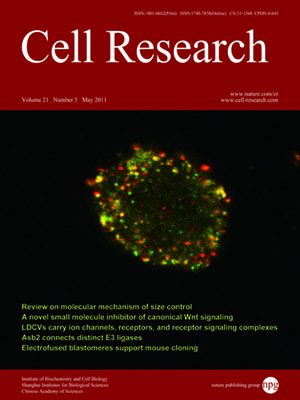
Volume 21, No 5, May 2011
ISSN: 1001-0602
EISSN: 1748-7838 2018
impact factor 17.848*
(Clarivate Analytics, 2019)
Volume 21 Issue 5, May 2011: 817-834
ORIGINAL ARTICLES
Mitochondrial H2O2 generated from electron transport chain complex I stimulates muscle differentiation
Seonmin Lee1, Eunyoung Tak1, Jisun Lee1, MA Rashid1, Michael P Murphy2, Joohun Ha1 and Sung Soo Kim1
1Department of Biochemistry and Molecular Biology, Medical Science and Engineering Research Center for Bioreaction to Reactive Oxygen Species and Biomedical Science Institute (BK-21), School of Medicine, Kyung Hee University, #1, Hoegi-dong, Dongdaemoon-gu, Seoul 130-701, Korea
2MRC Mitochondrial Biology Unit, Hills Road, Cambridge CB2 0XY, UK
Correspondence: Sung Soo Kim,(sgskim@khu.ac.kr)
Mitochondrial reactive oxygen species (mROS) have been considered detrimental to cells. However, their physiological roles as signaling mediators have not been thoroughly explored. Here, we investigated whether mROS generated from mitochondrial electron transport chain (mETC) complex I stimulated muscle differentiation. Our results showed that the quantity of mROS was increased and that manganese superoxide dismutase (MnSOD) was induced via NF-κB activation during muscle differentiation. Mitochondria-targeted antioxidants (MitoQ and MitoTEMPOL) and mitochondria-targeted catalase decreased mROS quantity and suppressed muscle differentiation without affecting the amount of ATP. Mitochondrial alterations, including the induction of mitochondrial transcription factor A and an increase in the number and size of mitochondria, and functional activations were observed during muscle differentiation. In particular, increased expression levels of mETC complex I subunits and a higher activity of complex I than other complexes were observed. Rotenone, an inhibitor of mETC complex I, decreased the mitochondrial NADH/NAD
+ ratio and mROS levels during muscle differentiation. The inhibition of complex I using small interfering RNAs and rotenone reduced mROS levels, suppressed muscle differentiation, and depleted ATP levels with a concomitant increase in glycolysis. From these results, we conclude that complex I-derived O
2·
−, produced through reverse electron transport due to enhanced metabolism and a high activity of complex I, was dismutated into H
2O
2 by MnSOD induced via NF-κB activation and that the dismutated mH
2O
2 stimulated muscle differentiation as a signaling messenger.
Cell Research (2011) 21:817-834. doi:10.1038/cr.2011.55; published online 29 March 2011
FULL TEXT | PDF
Browse 2294


